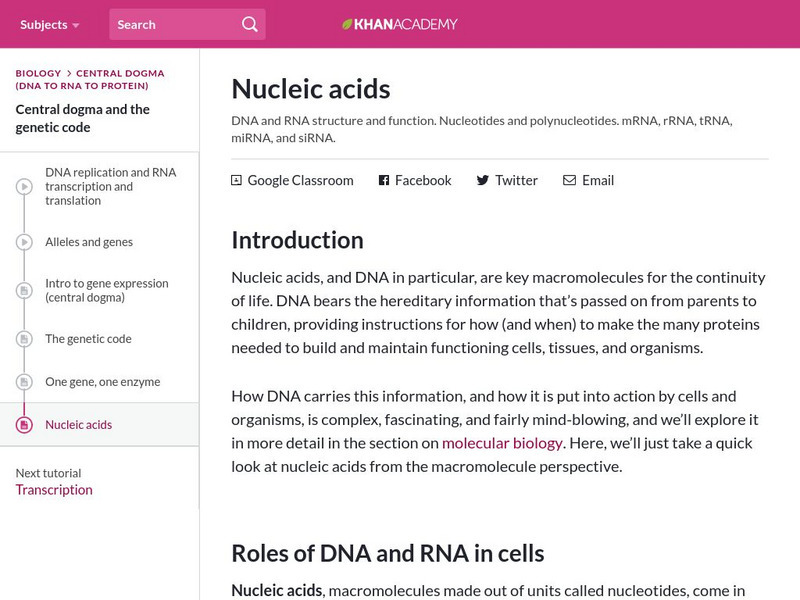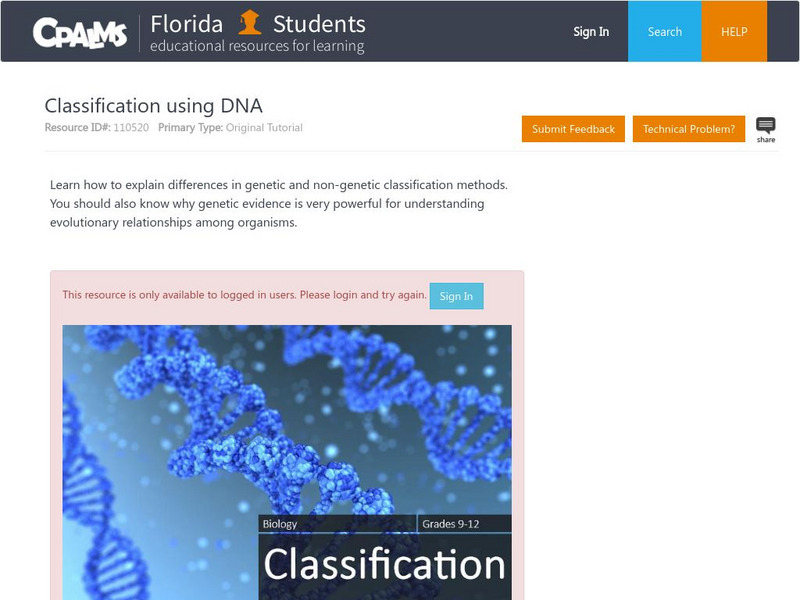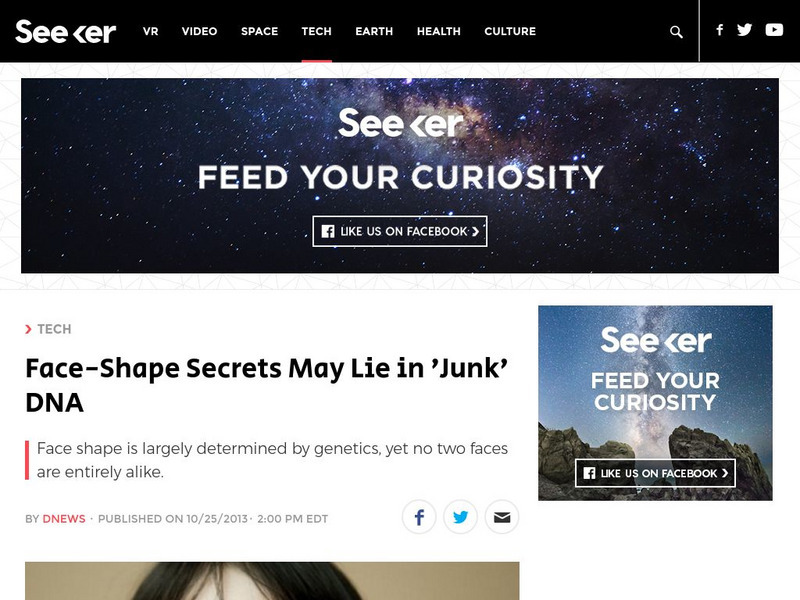Khan Academy
Khan Academy: Nucleic Acids
Discover the structure and function of DNA and RNA, and understand nucleotides and polynucleotides.
Khan Academy
Khan Academy: Overview: Eukaryotic Gene Regulation
Get the big picture of eukaryotic gene regulation, and learn how different genes are expressed in different cell types.
Khan Academy
Khan Academy: Dna Sequencing
Learn how the sequence of nucleotide bases (As, Ts, Cs, and Gs) in a piece of DNA is determined.
University of Utah
University of Utah: Learning Center: Learn Genetics:the Outcome of Mutation
Mutation is a process that changes a DNA sequence. But how does a difference in a gene's DNA sequence (or genotype) lead to a difference in an observable trait (or phenotype)?
CPALMS
Florida State University Cpalms: Florida Students: Classification Using Dna
Identify the differences in genetic and non-genetic classification methods. Why is genetic evidence powerful for understanding evolutionary relationships among organisms? Find out!
CPALMS
Florida State University Cpalms: Florida Students: The Story of Our Start
Learn how offspring are created through the processes of sexual and asexual reproduction.
CPALMS
Florida State University Cpalms: Florida Students: Yes or No to Gmo?
Discover the purpose of genetic engineering in agriculture. Explore the pros and cons of genetic modification.
Famous Scientists
Famous Scientists: Erwin Chargaff
Learn about the Austrian biochemist and author, Erwin Chargaff, best known for "Chargaff's Rules" which lead to the discovery of DNA's double helix structure.
Museum of Science
Museum of Science and Industry: Online Science: Activities: Extract Dna
An experiment where students remove DNA from strawberries using everyday materials.
Seeker
Seeker: Week of 10 28 13: Face Shape Secrets May Lie in 'Junk' Dna
Article reports that the secret to differences in face-shape may be found in the non-coding sequences of DNA, also known as "junk" DNA.
National Institutes of Health
U.s. National Library of Medicine: What Is Dna?
Scientific information about the hereditary material in all living things, DNA. Also includes links to fact sheets for quick reference.
CK-12 Foundation
Ck 12: Biology: Chromosomes
[Free Registration/Login may be required to access all resource tools.] An introduction to chromosomes.
CK-12 Foundation
Ck 12: Biology: Nucleic Acids
[Free Registration/Login may be required to access all resource tools.] Discusses the structure and role of nucleic acids.
CK-12 Foundation
Ck 12: Biology: Rna
[Free Registration/Login may be required to access all resource tools.] Overview of RNA and its three main types.
CK-12 Foundation
Ck 12: Transcription Factors Advanced
[Free Registration/Login may be required to access all resource tools.] This article complete with labeled diagrams, key vocabulary terms, and review questions explains the different factors involved in transcription.
OpenStax
Open Stax: Lydia E. Kavraki: Protein Folding
This module introduces students to the problem of Protein Folding, its importance, and current computational methods used to attack its complexity.
Cold Spring Harbor Laboratory
Cold Spring Harbor Laboratory: History
Founded in 1904 this site traces the advances in the study of genetics from then to the present time.
Other
Digital World Biology: Blas Ting Through the Kingdom of Life
Use BLAST to identify unknown sequences. GenBank contains over 3 million sequences, with over 14 billion nucleotides. BLAST can be used to compare an unknown sequence to all the sequences in the database, and find sequences that match....
American Museum of Natural History
American Museum of Natural History: Dna Base Pairs O Logy Card
Flip this interactive OLogy card to find questions and answers, fast facts, and other bite-size pieces of information to help you understand DNA bases A, T, G, and C.
American Museum of Natural History
American Museum of Natural History: Human Genome Project O Logy Card
Flip this interactive OLogy card to find questions and answers, fast facts, and other bite-size pieces of information to help you understand important characteristics of the Human Genome Project.
Nobel Media AB
The Nobel Prize: James Watson Biographical
Read about James Dewey Watson, the co-recipient of the 1962 Nobel Prize in Medicine for his work with Franice Crick on decoding the structure of DNA. This article includes information on both Watson's personal life and public career.
Nobel Media AB
The Nobel Prize: The Nobel Prize in Physiology or Medicine 1962 Award Ceremony
Here you can find the full text of the speech, by Professor A. Engstrom, presenting the 1962 Nobel Prize in Physiology or Medicine to Maurice Wilkins, James Watson, and Francis Crick for their discovery of DNA's structure. The speech...
Read Works
Read Works: Cloned Canine
[Free Registration/Login Required] An informational text about the first scientists to successfully clone a dog. A question sheet is available to help students build skills in reading comprehension.
Read Works
Read Works: Two Sets to Build Difference
[Free Registration/Login Required] An informational text about Charles Darwin's research on trait variations in the Galapagos Islands. A question sheet is available to help students build skills in reading comprehension.

























